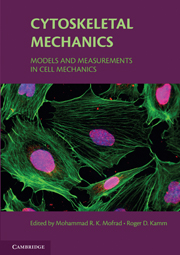Book contents
- Frontmatter
- Contents
- List of Contributors
- Preface
- 1 Introduction, with the biological basis for cell mechanics
- 2 Experimental measurements of intracellular mechanics
- 3 The cytoskeleton as a soft glassy material
- 4 Continuum elastic or viscoelastic models for the cell
- 5 Multiphasic models of cell mechanics
- 6 Models of cytoskeletal mechanics based on tensegrity
- 7 Cells, gels, and mechanics
- 8 Polymer-based models of cytoskeletal networks
- 9 Cell dynamics and the actin cytoskeleton
- 10 Active cellular protrusion: continuum theories and models
- 11 Summary
- Index
3 - The cytoskeleton as a soft glassy material
Published online by Cambridge University Press: 10 November 2009
- Frontmatter
- Contents
- List of Contributors
- Preface
- 1 Introduction, with the biological basis for cell mechanics
- 2 Experimental measurements of intracellular mechanics
- 3 The cytoskeleton as a soft glassy material
- 4 Continuum elastic or viscoelastic models for the cell
- 5 Multiphasic models of cell mechanics
- 6 Models of cytoskeletal mechanics based on tensegrity
- 7 Cells, gels, and mechanics
- 8 Polymer-based models of cytoskeletal networks
- 9 Cell dynamics and the actin cytoskeleton
- 10 Active cellular protrusion: continuum theories and models
- 11 Summary
- Index
Summary
ABSTRACT: Using a novel method that was both quantitative and reproducible, Francis Crick and Arthur Hughes (Crick and Hughes, 1950) were the first to measure the mechanical properties inside single, living cells. They concluded their groundbreaking work with the words: “If we were compelled to suggest a model (of cell mechanics) we would propose Mother's Work Basket – a jumble of beads and buttons of all shapes and sizes, with pins and threads for good measure, all jostling about and held together by colloidal forces.”
Thanks to advances in biochemistry and biophysics, we can now name and to a large degree characterize many of the beads and buttons, pins, and threads. These are the scores of cytoskeletal proteins, motor proteins, and their regulatory molecules. But the traditional reductionist approach – to study one molecule at a time in isolation – has so far not led to a comprehensive understanding of how cells are able to perform such exceptionally complex mechanical feats as division, locomotion, contraction, spreading, or remodeling. The question then arises, even if all of the cytoskeletal and signaling molecules were known and fully characterized, would this information be sufficient to understand how the cell orchestrates complex and highly specific mechanical functions? Or put another way, do molecular events playing out at the nanometer scale necessarily add up in a straightforward manner to account for mechanical events at the micrometer scale?
We argue here that the answer to these questions may be ‘No.’ We present a point of view that does not rely on a detailed knowledge of specific molecular functions and interactions, but instead focuses attention on dynamics of the microstructural arrangements between cytoskeletal proteins.
- Type
- Chapter
- Information
- Cytoskeletal MechanicsModels and Measurements in Cell Mechanics, pp. 50 - 70Publisher: Cambridge University PressPrint publication year: 2006
- 3
- Cited by



